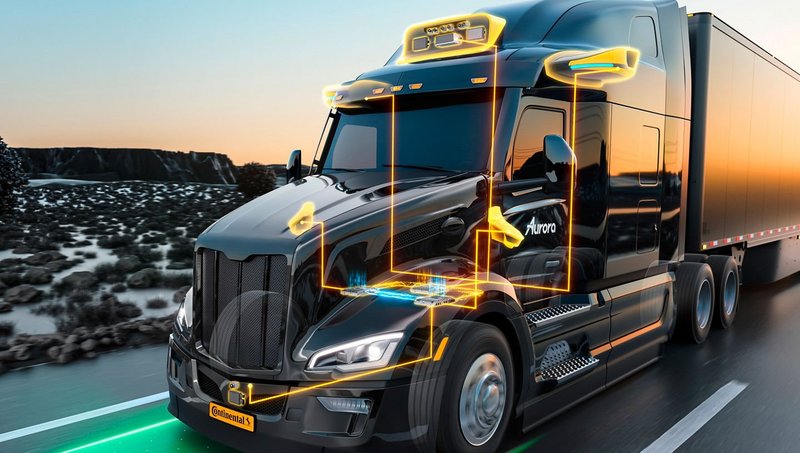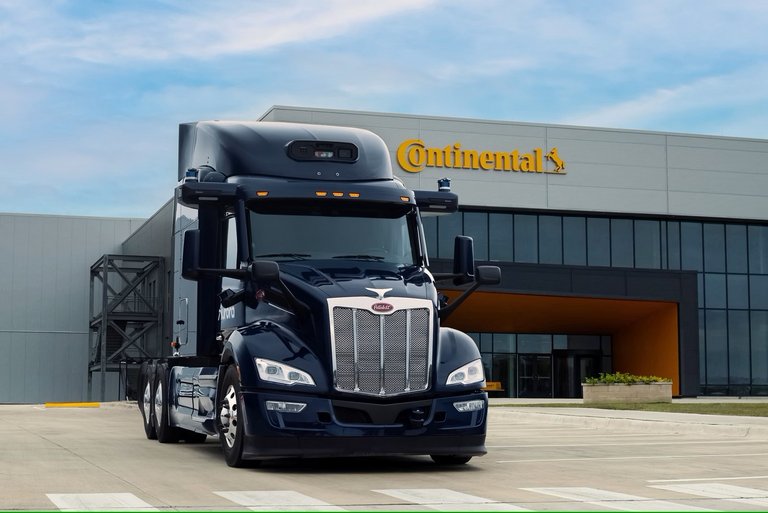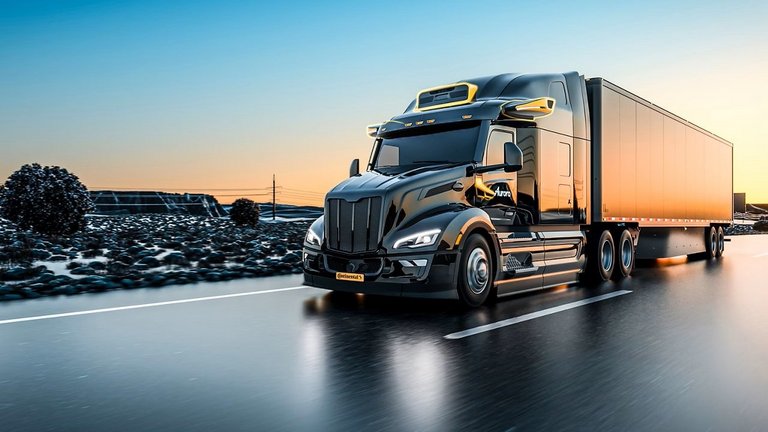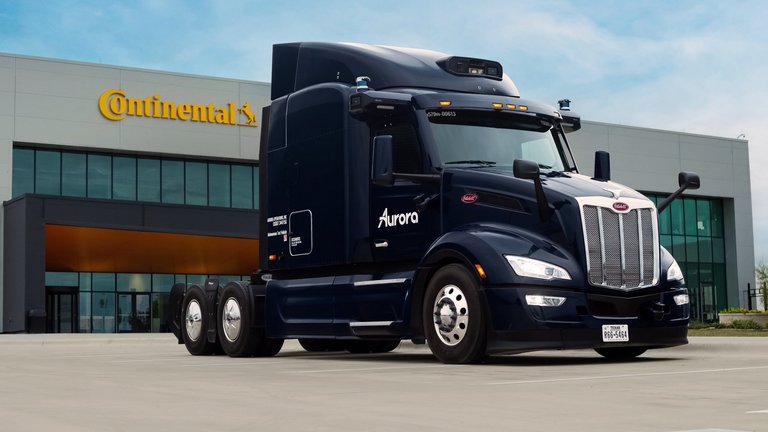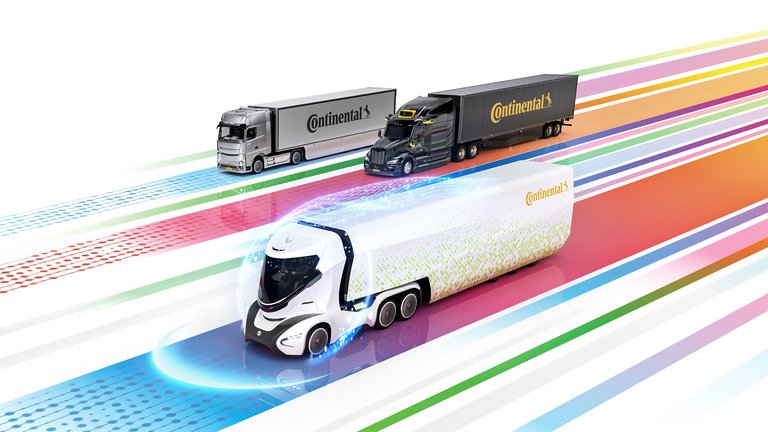Autonomous Trucks with High-tech Power from Continental
A vision becomes reality
A big semitrailer truck cruises along the Interstate 10 highway headed for Houston, Texas. Its cargo? Fresh strawberries from the California coast. The special thing about this apparently everyday freight transport is that no one is sitting behind the wheel – the truck drives itself. A utopia? More like a snapshot of the near future. In fact, after millions of monitored test kilometers under real traffic conditions and in simulated tests, fully self-driving trucks are about to make their debut on US highways – thanks to key technology from Continental on board, developed together with partner Aurora. Here, built-in safety systems play a crucial role.
Autonomous driving is increasingly within grasp – including in the commercial vehicle sector. What only a few years ago seemed like a distant vision is now taking shape. “For a long time it was just an idea, then it was a plan – now it’s a reality: autonomous trucks,” said CEO Nikolai Setzer at Continental’s Annual Shareholders’ Meeting in April 2024, summing up the state of affairs. Together with partner Aurora, Continental is steadily driving the development forward and is on course to put the world’s first scalable autonomous truck system on the road by the end of 2027. The general expectation within the industry is that thousands of self-driving trucks will then be able to transport freight safely and efficiently across the USA. The basis for this is an overall technological concept in which Continental’s successful sensor technology plays a key role.
Freight forwarders under pressure
The move toward autonomous trucks is attractive to the logistics industry for a number of reasons. In many countries, the industry is suffering from a huge shortage of drivers, while demand for goods transportation by road continues to grow. According to studies, Germany alone was short of at least 70,000 truck drivers in 2023 – and the trend is rising, since the number of those retiring each year is double that of new entrants to the profession. Other countries, particularly the USA, are also experiencing severe staff shortages.
Furthermore, the switch to driverless trucks offers fleet operators the opportunity to significantly reduce operating costs and delivery times. This is because autonomous trucks significantly increase transport efficiency – with a much higher level of safety. Unlike a driver in the cab, they do not need to observe driving times and rest breaks, but can drive around the clock. Self-driving trucks also lower the burden on the environment: optimized driving performance reduces fuel consumption, making fleet CO2 targets achievable.
In short, autonomous trucks have the potential to revolutionize the transport and logistics industry by offering greater efficiency, improved safety, lower operating costs and more sustainability. These benefits are reflected in studies such as the 2023 study by market research institute Fortune Business Insights. According to this, the global market for autonomous trucks is expected to grow from $35.5 billion in 2024 to around $76 billion in 2032, with an annual growth rate of 10 percent over the forecast period.
Continental makes headway in autonomous driving
Continental is systematically pursuing the market opportunities for autonomous trucks. Central hardware and software components and long-term success in vehicle sensor technology form the basis for this (link). Driver assistance systems with sensors from Continental already help millions of car drivers around the world when parking, keeping in lane on the highway or emergency braking, for example.
In the commercial vehicle sector, Continental has been working with US software company Aurora on a system solution for self-driving trucks since 2022. At its heart is the Aurora Driver – a hardware and software system that the two partners want to make ready for production by 2027 as the world’s first scalable autonomous truck system. Aurora cooperates with major truck manufacturers in the USA, such as Peterbilt, and has for years been testing self-driving trucks extensively on US highways – initially with safety personnel on board.
In just a few years, trucks featuring the autonomous truck system from Continental and Aurora will be driving autonomously and safely in the USA. At the beginning of 2024, the partners finalized the system architecture, design and technical specifications for the Aurora Driver hardware – an important development milestone on the road to implementation.
Driverless mobility part of Continental's DNA
Continental brings more than five decades of expertise in autonomous driving to the partnership with Aurora. As early as 1968, the first electronically controlled, driverless test vehicle made its rounds at the Contidrom test site near Hanover. At the end of the 1990s, the starting signal was given for the development of sensors as the basis for driver assistance systems. "Continental now has around 25 years of experience in sensor solutions from individual components to complete systems. In 2023 alone, Continental produced more than 39 million cameras, radar and lidar sensors for assisted and automated driving functions.
In the development and production of radar sensors for the automotive industry, Continental has been one of the industry's leading suppliers for many years. With the sixth generation of long-range and environmental radars, Continental is continuing this success story. The latest generation of radar offers significantly higher performance, resolution and range compared to previous models. By 2023, Continental had manufactured more than 100 million radar sensors worldwide.
System expertise for autonomous trucks
In its partnership with Aurora, Continental has the task of combining the individual components of the autonomous driving system into an overall solution and smoothing the way for its industrialization. Continental is also contributing many important components for the functions of the Aurora Driver itself. These predominantly include radar and camera sensors as well as jointly developed LiDAR sensors (see cutaway model). As a kind of nervous system, they form the central interface to the outside world for the self-driving truck. Continental also supplies central control units for automated driving and high-performance computers (HPCs) with enormous computing power for processing the collected mobility data, telematics units for connectivity and a second safety system whose software assumes control in the event that the primary autonomous truck driving system fails.
Interaction of sensors
Continental provides the truck system with the senses required for autonomous driving. The company does not only rely on cameras, i.e. the “eyes” of the vehicle, but also uses radar and LiDAR (Light Detection and Ranging) sensors. The sensors record the outside world in a similar way to human sensory organs to create the best possible image of the vehicle surroundings, which the truck software then converts into autonomous driving functions. The three technologies complement one another and provide data on nearby and distant objects, their speed and direction of motion. The cameras produced by Continental, for example, detect people, road boundaries (in color) and traffic signs. The radar sensors use electromagnetic waves to measure the distance to other vehicles and their relative speed – in a similar manner to how bats orient themselves using the echoes of the ultrasonic sounds they emit. LiDAR sensors detect objects up to a distance of 400 meters. Compared with cars, autonomous truck systems require more powerful sensors and, due to the more complex sensor data, significantly higher computing power.
Maximum safety thanks to redundant systems
Continental takes questions regarding the safety of autonomous vehicles and the widespread skepticism towards driverless trucks seriously. It is an undisputed fact that human error is the main cause of accidents and that autonomous trucks can help to significantly increase road safety. The powerful combination of advanced sensor technology and cameras is an important building block in this regard. The fallback system developed by Continental provides a further network for the greatest possible safety through redundancy. At its core is a high-performance computer that runs in parallel with the primary Aurora Driver system, continues to steer the truck in an emergency and brings it safely to a halt. This dual approach clearly demonstrates that maximum safety in autonomous driving is a top priority for Continental and goes hand in hand with the protection of all road users. By turning this guiding principle into successfully tested technological solutions, Continental is helping to increase the social acceptance of autonomous driving in general and of heavy commercial vehicles in particular.
2027 firmly in sight
How quickly the further development of safe autonomous trucks progresses from testing under real traffic conditions to successful rollout depends on many factors. In addition to technological expertise, a country’s topography, size, population density and regulations also play an important role. Here, the large size of the USA offers advantages over smaller countries. The US market is currently the most important and biggest for trucks with autonomous driving technology. The attractive infrastructure with its extensive highway network and large truck fleets also make North America Continental’s preferred testing ground for the new technology – with the aim of moving from test operation to market maturity by the end of 2027.
Glossary
What is what in autonomous driving?
Level 0-5
Experts distinguish between six levels of automation. This definition is from the SAE (Society of Automotive Engineers) and its J3016 standard dated 2014. It is internationally recognized today.
No driving automation – the driver fully controls the car without exception.
During assisted driving, assistance systems such as distance warning and cruise control support the driver. This stage is currently widely used, right down to the small car segment.
Partial driving automation can assume certain driving functions such as steering and lane keeping or semi-automated parking. However, the driver remains responsible and liable for all maneuvers. Models such as Tesla’s Model S, Model M and Model X or the BMW 5 Series are already capable of Level 2.
During conditional driving automation, the driver must be able to intervene at any time, but may also turn their attention to other things when the system is activated. The driver can be prompted to take control again following an advance warning. Level 3 features as standard in the Mercedes S-Class, for example.
During high driving automation, the vehicle is predominantly autonomous in a defined environment, for example on highways, selected routes or in specific city districts. If the primary driving system fails, a back-up must be able to intervene – this can be either the driver or a redundant emergency system. This level is currently being tested in practice by a number of car manufacturers, suppliers and tech companies.
During full driving automation, no driver is required, and the vehicle assumes all driving functions without restriction on all routes. There is no need for a steering wheel or pedals. All of the occupants become passengers.
